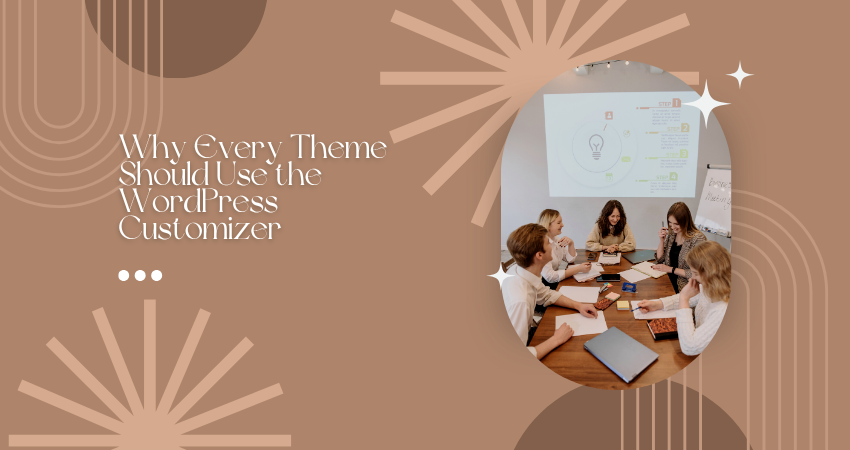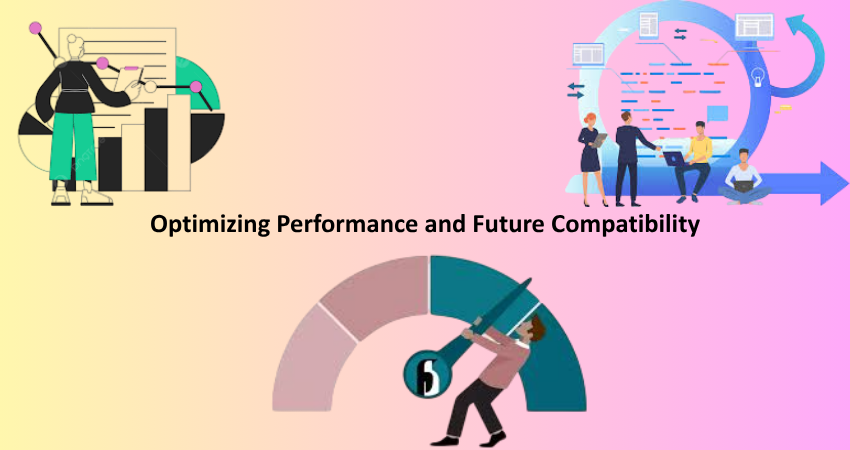
Introduction
WordPress Customizer is an amazing way to live customize a website. Users will use it to change how their sites look and function. Thus customization has naturally become an important component of WordPress development over the years: It provides an interface to theme developers and users without having to code anything. For theme developers and their end-users, integrating the Customizer ensures compatibility, enhances usability, and provides a consistent editing experience. The WordPress Customizer took its place in the center of modern theme development, with the evolution of other visual builders and block-based solutions standing in spite.
The WordPress Customizer is not just the flavor of the day; it became an important feature to have when it comes to ensuring accessibility, flexibility, and ease of use. In the open-source spirit of WordPress, where user empowerment is at the center, theme developers need to put their users first when it comes to matters of simplicity, control, and live previews. In this article, we will talk about why every theme for WordPress should be using the Customizer, what advantages come along with it, and further implications for theme quality, performance, and user satisfaction.
Enhancing User Experience Through Live Previews
Real-Time Feedback Builds Confidence
An important strength of the WordPress Customizer is real-time previewing. Users seeing the result of one change to the site allows them to be confident in making other changes, feeling assured not to break it. This live feedback loop prevents guesswork and shaves off friction for perhaps the most important group: non-technical users. Whatever color or font change is made, or layout changed: every edit is instantly visible and allows the user to play and iterate with confidence. This fosters trust in the theme and with WordPress as a whole.
This sort of real-time user interface is good news for theme developers since this could mean less support tickets and higher user satisfaction levels: to visually confirm their action means they won’t find themselves confused or frustrated. Instead of vaguely labeled backend options, end-users benefit from an interactive interface that is intuitive; and one that improves user experience, particularly for the beginner. This accessibility helps bridge the gap between advanced users and novices, making your theme appealing to an even wider audience.
Seamless Design Control for Non-Coders
The WordPress Customizer provides a low barrier to entry for those with little to no coding knowledge. By giving them the opportunity to change the theme settings, layout options, and content visibility without editing theme files, users have now taken ownership of their website design. With this democratization of design control, even more users can independently engage in website customization. Each customization feature is easy to use such that users have drag-and-drop widgets, section reordering, and simple toggles to reconfigure complex layouts.
By embedding Customizer controls into your theme, you empower users to access the core and easy-to-use customization features without additional customizing plugins. That keeps things light, secure, and operating under core WordPress functions. Moreover, themes that respect Customizer support tend to rank higher among user reviews and find more adoptions as they provide usability and clarity. In an industry where user satisfaction crowns the king of success for a theme, thus becomes a mighty selling point on seamless design control.
Streamlining Theme Development and Maintenance

Consistent Standards and Practices
It means if you design your theme according to core WordPress standards by using the WordPress Customizer, you will get a clearer and more consistent code base. The structure given by customizer API is well documented, extensible, and will enable a developer to work away from spaghetti code and encourage modularity. Furthermore, if something were to go wrong with inherent standards put in place, it tends to eliminate issues like conflicts, bugs, or the confusion where users have inconsistent or proprietary settings panels. It also makes it easy for a team of developers to work on one project.
It is future-proofing the theme because, from the onset of theme development, you have incorporated the Customizer. Since the Customizer is part of the core of WordPress, changes in functions or improvements will be ensured to work backward and forward with tested results. There will be minimum burdens left on the maintenance of the theme authors while leaving the theme open to work with future versions of WordPress. Ultimately, this will lead to a more stable as well as more cost-efficient and time-saving theme in the longer run.
Easier Debugging and Custom Feature Integration
Theme users of the WordPress Customizer will have fast debugging. Since the architecture of Customizer is modular, it will be quite easy to isolate and test individual settings or controls for errors. Such structured formats allow one to view the components as granular and that is very much beneficial indeed when it comes to troubleshooting or refining the user interface. Things like additional functions can also be handled through Customizer API, which should support conditional logic, sanitation, and dealing with live data.
It would also have more powers for other unique custom sections to be built depending on some specific features of the theme. Would you like to add a hero section editor, homepage layout switcher, etc. You can do this very cleanly with the Customizer and retain a cohesive overall design workflow. For developers interested in enhancing their themes with custom settings, the Customizer provides a trusted and scalable platform. It also makes it possible to extend functionality while remaining true to the core WordPress guidelines, ensuring future compatibility and a better experience for everyone.
Boosting Theme Marketability and User Trust
User Expectations and Competitive Edge
Nowadays, theme users are expecting customization to be easy and readily available. Any theme that does not support WordPress Customizer is expected to be labeled as ‘outdated’ or ‘hard to use.’ Customers visiting theme directories or marketplaces will often filter by features such as “Customizer support,” so it is a must-check for visibility. The inclusion of the Customizer means users get what they expect, and in terms of visibility in highly competitive marketplaces like ThemeForest or the official WordPress theme directory, Customizer support is an advantage.
The more personalizable a theme is, the greater the chances for good ratings and recommendations. Happy users will share and promote themes they find easy, thus increasing discoverability and sales. The Customizer becomes a must-have, rather than an add-on, in an age where user experience dictates what is purchased. Theme developers who embrace this tool show that they are focused on quality and the empowerment of the user.
Brand Consistency and Client Satisfaction
By enabling the users and clients to manage branding elements like colors, typefaces, and logos freely, they are likely to create a fairly uniform and well-polished look. This is perhaps the most crucial control for businesses and bloggers who need to present a very professional online identity. The WordPress Customizer will ultimately allow site owners to align their sites more closely with brand requirements without the need for intervention from a developer, thus saving time and budget but while still having a high-quality show.
From a developer-client standpoint, themes using the Customizer also reduce the hand-holding and revision cycles as it helps manage it all for the client. Clients enjoy having clear labels with regard to controls within a centralized, easily usable architecture. When your theme delivers such functionality out-of-the-box, the customer satisfaction will be better, and trust will grow. In the end, this will build up and develop into a deepened relationship for repeat business and word-of-mouth referrals-all of which are invaluable to the independent developer and the agency.
Optimizing Performance and Future Compatibility

Lightweight Customization Without Bloat
This is yet another of those unsung advantages that WordPress Customizer has and it enables you not to add fluff to your theme with options that are otherwise available. It is tied up very tightly into the WordPress core unlike all that third-party page builders and bloated option panels, and it is optimized for speed as well. So the theme remains fast, responsive, and secure even while using these options. Because performance deeply affects user experience and search engine rankings, a lean approach to customization tools becomes very strategic.
With the Customizers, theme developers can offer some of the most necessary essential design controls without relying on bulky external frameworks which leave plugin conflict risk open and increase load times. Performance-first features cause your theme not only to satisfy users but also meet technical expectations from developers and search engine optimization pros. All in all, the Customizer makes sure that your theme runs underneath as efficiently as it looks from the surface.
Preparing for WordPress’s Evolution
There is, of course, a difference between migration into cutting edge technologies-consideration passed when developing new features into consideration for all the old tools that are still very much present. Customizer becomes a bridge during such transitional phases. Indeed, while block-based themes and globally applicable styles are reaching most users, a huge cadre of users still remains clinging onto their traditional themes powered by Customizer because they give a sense of stability and familiarity. Supporting the Customizer ensures that the theme remains accessible to a wider user-base during this transition.
Also, Customizer can be used to offer new features when it follows a legacy model. Developers are likely to bring block previews, align typography definitions, or even add color palette options that act as that available in the site’s editor for use in shaping the future of an argument. This makes your theme robust for the future as it prepares it against further releases from WordPress, yet not breaking the proven benefits offered by Customizer. As WordPress keeps growing, so will the classes that harmonize both innovation and user familiarity be valuable and relevant.
Conclusion
The WordPress customizer is much more than a luxury. It’s actually a critical source for modern theme development. Theme developers who adopt the capability to the fullest extent will increase the usability, improve compatibility, and put themselves in a position of long-term success. The Customizer, however, has the tools and infrastructure to deploy all funds regardless of whether the goal is affordability to nontechnical users, streamlining development processes, or maintaining competitiveness in a crowded marketplace.
However applying Customizer does not only yield best practice; it is also a strategic advantage. As WordPress evolves, ease of use, accessibility, and visual feedback become the main criteria on which the themes will stand out. In the mind of real developers who want to stick out from the rest by coming up with great themes that would have an impact on users, using WordPress Customizer would never be a question.